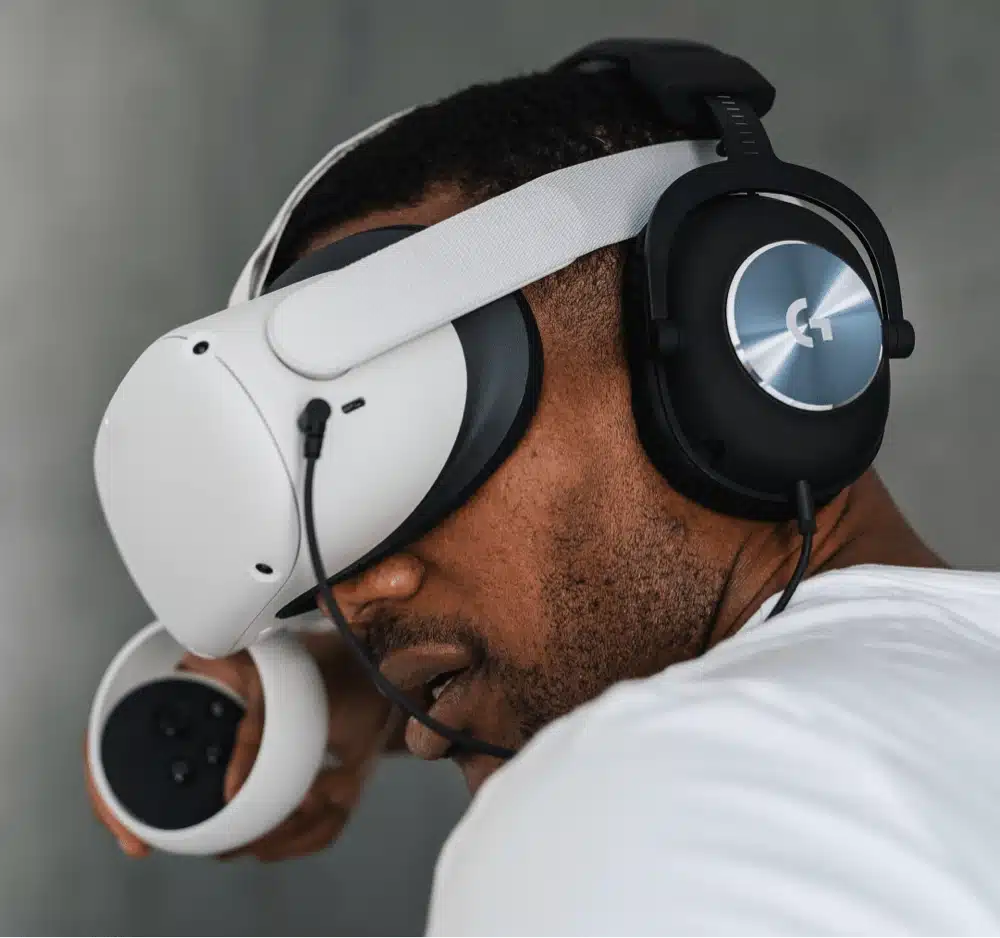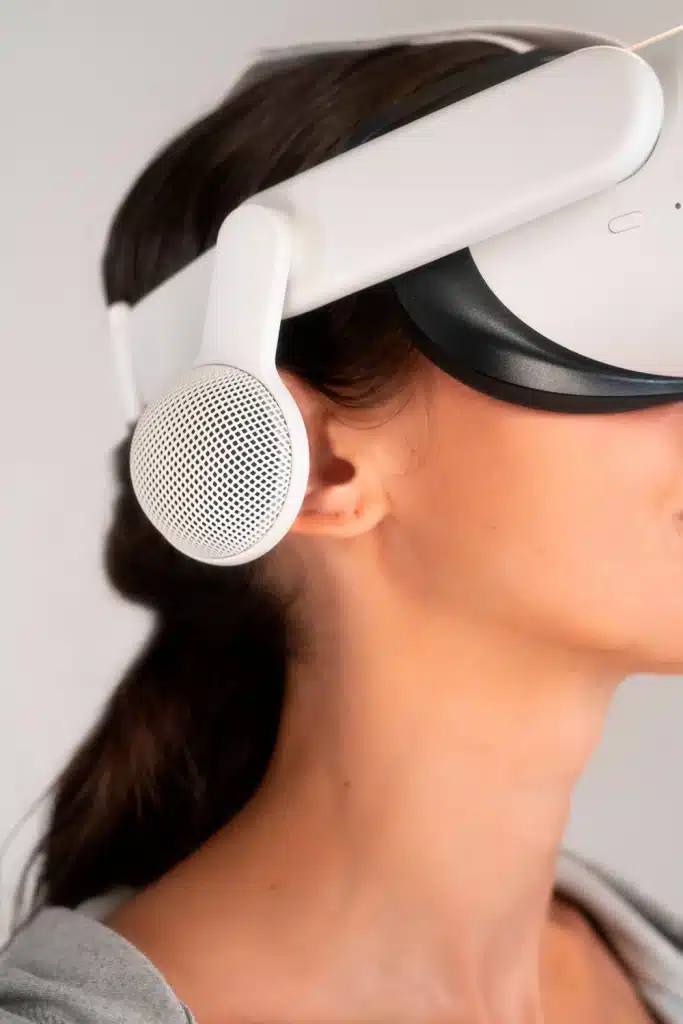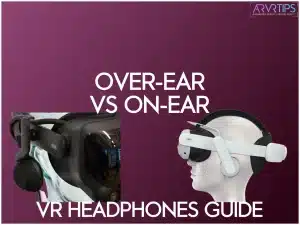Is it better to wear over-ear headphones that cover your entire ear in virtual reality or off-ear headphones that hover over top of your ears? In this guide, I’ll compare over-ear vs off-ear audio in full detail to tell you what the best option for your VR headset is.,
Key Takeaways
Choosing between over-ear and off-ear audio for VR comes down to comfort, sound quality, and use case.
- Over-ear headphones offer excellent sound isolation and deep bass, making them ideal for competitive gaming and immersive experiences. However, they can cause discomfort over long sessions due to heat and pressure.
- Off-ear audio provides better comfort for extended use, with no direct contact and improved airflow. It’s great for social VR, fitness, and maintaining awareness of your surroundings, but lacks noise isolation and may leak sound.
VR Headphones Quick Comparison
| Feature | Over-Ear Audio | Off-Ear Audio |
|---|---|---|
| Comfort | Can cause heat/pressure | No contact, better airflow |
| Sound Quality | Strong bass, isolated | Natural, immersive spatial |
| Noise Isolation | Excellent | Limited |
| Awareness | Low | High |
| Use Cases | Gaming, movies | Fitness, social VR, training |
Over-Ear Audio in VR
Over-ear headphones (also known as on ear headphones) designed for VR fully cover the ear canal with cushioned ear cups and adjustable headbands.
This setup ensures a snug fit over your entire ear, while focusing on sound isolation and stability during VR use. Over ear headphones typically are more common to buy.
Why Over-Ear Audio Stands Out for VR
Over-ear headphones shine when it comes to delivering high-quality sound and blocking out external noise. Their design creates a physical seal around your ears, helping you stay immersed in VR. They also work well with your ear’s natural shape to improve spatial audio, making the sound feel more three-dimensional.
Drawbacks of Over-Ear Audio in VR
However, these headphones aren’t without flaws. They can get warm during long sessions, lead to ear fatigue due to constant contact, and may feel uncomfortable because of limited airflow. Their size can also make them tricky to pair with some VR headsets. To stay comfortable, users often need to take breaks during extended use.
While over-ear audio delivers excellent sound, its comfort issues push some users to explore off-ear options as a more practical choice.

Off-Ear Audio in VR
Off-ear audio is a sound delivery method for VR where speakers hover near your ears without touching them. Unlike traditional over-ear headphones, which create a seal around the ears, off-ear audio leaves a small gap.
This design allows sound to interact naturally with the shape of your ears while avoiding the pressure points caused by contact. However, off ear headphones do not offer active noise cancellation, so you’ll want to use them more in quiet environments.
Why Off-Ear Audio Works Well for VR
Off-ear audio brings several benefits to the VR experience. Systems like the Valve Index use this approach to deliver high-quality spatial audio without touching the ears. This setup enhances spatial sound positioning, making virtual environments feel more immersive.
Comfort is another major plus. Without the direct contact of traditional headphones, users can enjoy long VR sessions without discomfort from heat or pressure. The open design also promotes better airflow around the ears, reducing the chance of overheating.
Another advantage is improved awareness. Since your ears remain unobstructed, you’re more aware of your surroundings, which is especially useful in room-scale VR setups.

Drawbacks of Off-Ear Audio in VR
Off-ear audio isn’t perfect. One of its main downsides is poor noise isolation. Unlike over-ear headphones that block out external sounds, off-ear solutions leave your ears exposed, which can hurt immersion in noisy environments.
Another issue is sound leakage. Because the speakers are open, others nearby can hear what you’re listening to. This makes off-ear audio less ideal for shared spaces or late-night gaming. As highlighted by Road to VR:
“The difference in audio quality on Index compared to an audio pipe solution (like on Meta Quest) is vast, not even in the same league”.
While off-ear audio shines in comfort and spatial sound quality, its lack of noise isolation and potential for sound leakage may not suit every VR setup.
| Aspect | Impact on VR Experience |
|---|---|
| Comfort | High – No pressure or heat buildup |
| Sound Quality | Excellent – Works naturally with ear shape |
| Noise Isolation | Low – External sounds can interfere |
| Environmental Awareness | High – Keeps you aware of surroundings |
| Sound Leakage | Significant – Others can hear your audio |
Off-Eat Headphones for Meta Quest – Logitech Chorus VR Review
If you insist on off-ear headphones for VR, then there is a unique option for the Meta Quest you should know about. The Logitech Chorus are off-ear headphones that offer really high quality.
This Youtube video shows them off in a lot of detail.
Over-Ear vs. Off-Ear Comparison
Several factors determine how comfortable a VR audio solution feels.
For starters, weight distribution is key. Over-ear headphones can add extra bulk to a VR headset, which may throw off balance. Heat is another consideration – over-ear designs create a sealed environment around your ears, which can get warm quickly. Cheap on ear headphones are uncomfortable for long periods of all day wear unless they are well padded.
Then there’s the issue of pressure points. Over-ear headphones have large ear cups that press against the sides of your head and ears, which can become uncomfortable over time. On the other hand, off-ear solutions avoid this problem and sweaty ears altogether by keeping a small gap between the speakers and your ears.
Another factor is headset compatibility. Some VR headsets are specifically designed to work with their built-in audio systems, ensuring better ergonomics and weight balance. The Valve Index, for example, integrates an off-ear audio system that perfectly complements its design.
Comfort During Long VR Sessions
Long VR sessions can highlight the differences between these two audio options. Over-ear headphones often lead to discomfort due to heat buildup and pressure, forcing users to take breaks.
In contrast, off-ear solutions provide better ventilation and avoid direct contact, making them a better choice for extended use.
Staying comfortable not only helps you physically endure longer sessions but also keeps you immersed by eliminating distractions caused by discomfort.
Comfort Comparison Table
| Comfort Factor | Over-Ear Audio | Off-Ear Audio |
|---|---|---|
| Weight and Integration | Heavy – Adds bulk, varies by model | Light – Minimal weight, works best when built-in |
| Heat Management | Poor – Traps heat around ears | Great – Allows natural airflow |
| Pressure Points | High – Direct contact with ears | None – No physical contact |
| Long Session Comfort | Decreases over time | Stays consistent |
| Environmental Awareness | Limited – Blocks external sounds | High – Open design lets sound in |
Comfort is just one piece of the puzzle – sound quality and immersion also play a big role in picking the best VR audio solution.
Over-Ear vs Off-Ear Sound Quality and Immersion
Comfort matters, but sound quality and immersion are just as important for creating a great VR experience.
Audio Fidelity Comparison
Over-ear headphones are known for their strong sound isolation, delivering deep bass and detailed audio across a range of frequencies. These provide full-frequency audio with a 180-degree dispersion pattern. However, they don’t quite match the isolation levels of over-ear designs.
Beyond just sound quality, how audio interacts with spatial awareness is a key factor in VR immersion.
Effect on VR Immersion
High-quality audio enhances VR by improving spatial awareness and sound localization. Off-ear solutions allow sound to interact naturally with the shape of your ears, creating a more realistic sense of space without pulling you out of the experience.
In ear headphones have better sound isolation and are great for blocking distractions and diving deep into the VR world. However, this same isolation can feel unnatural in social VR settings or when you need to stay aware of your surroundings.
Sound Quality Comparison Table
| Audio Aspect | Over-Ear Audio | Off-Ear Audio |
|---|---|---|
| Bass Response | Strong, deep bass | Moderate, less impactful |
| Sound Isolation | Excellent, blocks external noise | Limited, lets ambient sound in |
| Spatial Audio | Less natural | More natural and immersive |
| Sound Leakage | Minimal | Noticeable |
| Environmental Awareness | Low | High |
| Audio Clarity | Precise and detailed | Clear but influenced by surroundings |
Choosing between over-ear and off-ear audio depends on how you plan to use VR. For gaming sessions where full immersion is key, over-ear headphones deliver the isolation and sound fidelity you need. But for social VR or activities where staying aware of your environment is important, off-ear solutions feel more natural and still deliver good audio quality.
Knowing these differences makes it easier to pick the right audio setup for your VR needs.
When to Use Over-Ear Audio in VR
Over-ear headphones are perfect for experiences where sound isolation is key. For competitive VR gaming, they block out external noise and enhance focus on critical audio cues. Titles like Beat Saber and Half-Life: Alyx especially benefit from their ability to deliver precise sound placement.
They also shine during VR movie sessions. Platforms like Bigscreen VR pair well with the deep bass and sound isolation of over-ear headphones, creating a theater-like experience.
When to Use Off-Ear Audio in VR
Off-ear audio is all about comfort and staying aware of your surroundings. The Valve Index, for example, uses composite honeycomb-panel drivers to deliver full-range sound while keeping you connected to the environment.
This setup works best for:
- VR Fitness: Apps like Supernatural or FitXR, where comfort and movement are essential.
- Social VR: Platforms like VRChat, where natural interaction and longer sessions are common.
- Educational Experiences: Virtual classrooms or training simulations, where spatial awareness is helpful.
Best Audio Solutions by VR Activity
| VR Activity | Recommended Solution | Best For |
|---|---|---|
| Competitive Gaming | Over-ear | Focused play, precise sound |
| Movie Watching | Over-ear | Immersive sound, private viewing |
| Fitness Apps | Off-ear | Comfort, situational awareness |
| Social VR | Off-ear | Long sessions, natural interaction |
| Educational/Training | Off-ear | Comfort, spatial awareness |
| Meditation | Off-ear | Relaxation, soft audio |
Choosing the right audio solution depends on your VR activities and priorities. Whether you’re diving into intense gameplay or enjoying a relaxing meditation session, the right setup enhances your experience.
Conclusion: Choosing VR Audio for Comfort
Over-ear headphones are great for sound isolation and high-quality audio, making them perfect for competitive gaming and immersive experiences. On the other hand, off-ear solutions focus on comfort and spatial awareness, which makes them better for longer sessions and a more natural sound experience.
However, over-ear designs can become uncomfortable during extended use due to heat and pressure.
Your choice of audio gear should depend on what you need most. Here’s a quick comparison:
| Usage Factor | Over-Ear Recommendation | Off-Ear Recommendation |
|---|---|---|
| Session Length | Best for shorter sessions (under 2 hours) | Ideal for longer sessions (2+ hours) |
| Environment | Works well in noisy spaces | Best for quiet rooms |
| Primary Use | Competitive gaming, movie watching | Social VR, fitness, training |
| Priority | Sound isolation, strong bass | Comfort, spatial awareness |
The table above can help you decide based on your main VR activities. Picking the right audio setup ensures a smooth and immersive experience tailored to what you need most.


